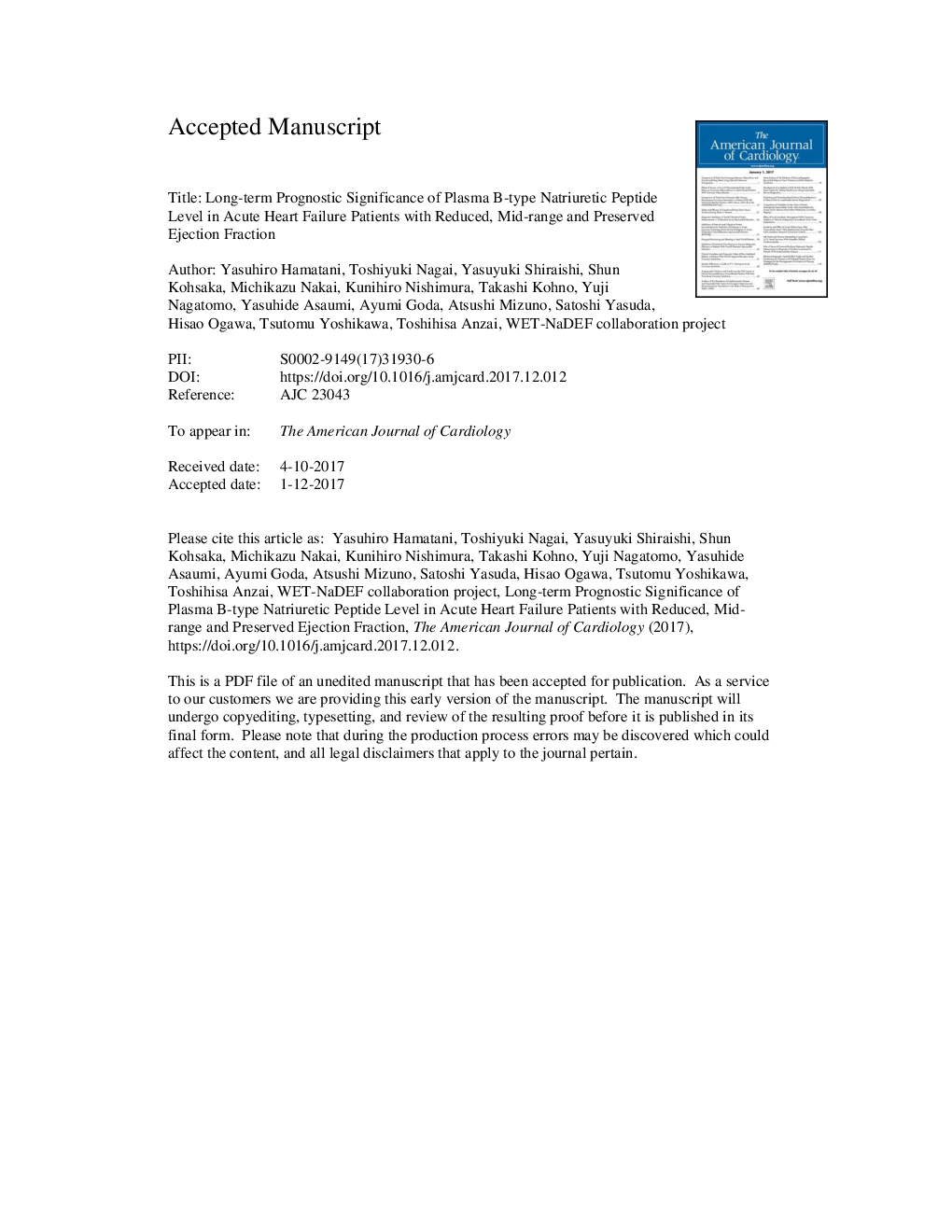| کد مقاله | کد نشریه | سال انتشار | مقاله انگلیسی | نسخه تمام متن |
|---|---|---|---|---|
| 8651472 | 1572065 | 2018 | 36 صفحه PDF | دانلود رایگان |
عنوان انگلیسی مقاله ISI
Long-Term Prognostic Significance of Plasma B-Type Natriuretic Peptide Level in Patients With Acute Heart Failure With Reduced, Mid-Range, and Preserved Ejection Fractions
دانلود مقاله + سفارش ترجمه
دانلود مقاله ISI انگلیسی
رایگان برای ایرانیان
موضوعات مرتبط
علوم پزشکی و سلامت
پزشکی و دندانپزشکی
کاردیولوژی و پزشکی قلب و عروق
پیش نمایش صفحه اول مقاله

چکیده انگلیسی
Plasma B-type natriuretic peptide (BNP) is an important prognostic marker in patients with acute heart failure (AHF). However, it is unclear which BNP parameter, on admission, at discharge, or change during hospitalization, has the highest predictive performance for long-term adverse outcomes, and whether its prognostic impact differs according to the new European heart failure (HF) phenotype classification by left ventricular ejection fraction: heart failure with reduced ejection fraction (HFrEF), heart failure with mid-range ejection fraction (HFmrEF), and heart failure with preserved ejection fraction (HFpEF). We examined 1,792 patients with AHF consisting of 860 (48%) HFrEFs, 318 (18%) HFmrEFs, and 614 (34%) HFpEFs. Prognostic performance of each BNP parameter was assessed by the Harrell c-index. During a median follow-up of 664 days, 344 (19%) patients died. Discharge BNP had the highest c-index (0.69) for mortality among all BNP parameters (pâ<0.001). In multivariate Cox proportional hazard modeling, discharge BNP was associated with mortality in HFrEF, HFmrEF, and HFpEF patients with significant interaction (hazard ratio [HR] 1.95, 95% confidence interval [CI] 1.57 to 2.41; HR 1.76, 95% CI 1.10 to 2.82; HR 1.46, 95% CI 1.12 to 1.91, respectively; pâ=â0.011 for interaction). Moreover, the c-index of discharge BNP for mortality in HFrEF patients (0.72) was higher than that in HFmrEF patients (0.68) and HFpEF patients (0.65). Similar results were obtained for mortality or HF rehospitalization as alternative outcomes, except there was no statistically significant interaction among HF phenotypes. In conclusion, discharge BNP is a more reliable marker than other BNP parameters on long-term outcome prediction in patients with AHF, but its prognostic impact may be weakened in HFmrEF and HFpEF compared with HFrEF.
ناشر
Database: Elsevier - ScienceDirect (ساینس دایرکت)
Journal: The American Journal of Cardiology - Volume 121, Issue 6, 15 March 2018, Pages 731-738
Journal: The American Journal of Cardiology - Volume 121, Issue 6, 15 March 2018, Pages 731-738
نویسندگان
Yasuhiro MD, Toshiyuki MD, PhD, Yasuyuki MD, PhD, Shun MD, PhD, Michikazu PhD, Kunihiro MD, PhD, Takashi MD, PhD, Yuji MD, PhD, Yasuhide MD, PhD, Ayumi MD, PhD, Atsushi MD, Satoshi MD, PhD, Hisao MD, PhD, Tsutomu MD, PhD, Toshihisa MD, PhD,